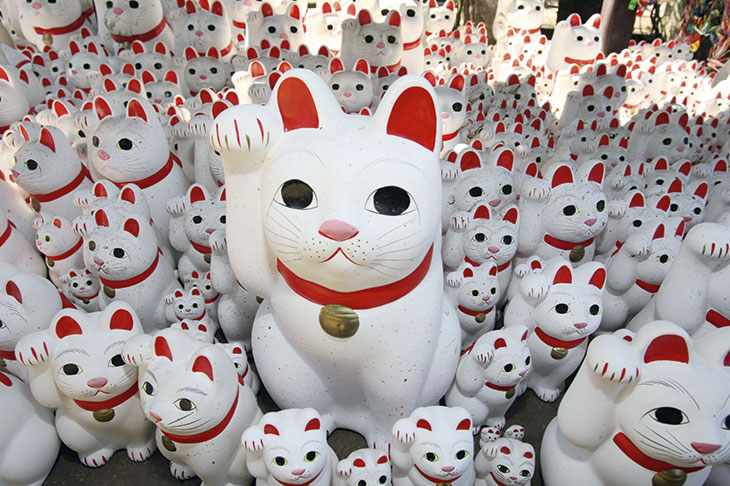Ordinarily, I love books that answer questions I’ve never asked, but Simon May’s baffling book has blown my mind. The self-deprecator in me wants to tell you I’m too stupid to understand a word of it. The rest of me suspects that this is a sneaking yet sparkling satire on what a university education will get you (£50,000 of debt and the authority to pronounce a penguin cuter than a mermaid).
I like the visiting professor of philosophy at King’s College London very much. ‘What is a bear with the head of a wolf?’, he demands. ‘Who is a human with cat’s eyes? What is the inner world of a sphinx “really”?’ He writes brilliantly and quotes exuberantly. The problem is his subject. Early on he explains that his approach to ‘Cute’ was inspired by Susan Sontag’s Notes On ‘Camp’ and Harry Frankfurt’s essay ‘On Bullshit’. But the former was so of its moment and the latter so enduring. By comparison The Power of Cute seems at best esoteric and at worst outdated. Most of the cultural artefacts of ‘Cute’ exhibited to us — ET, Mickey Mouse, Jeff Koons’s Balloon Dogs, Cabbage Patch Kids — are at least 20 years old.
Cute can’t be defined. Despite copious footnotes and a seven-page bibliography, it proves to be pindownable only in its ‘unpindownability’ and we are told this several times. But still, May makes bold claims for it. Cute, he reckons, was invented by the Japanese as a preserve against nuclear attack. ‘It’s a big jump in self-conception from Samurai to Cute, but it perfectly suits Japan’s historical position after the disaster of militarism,’ he argues. ‘Where today Germany does remorse, Japan does Cute, a spirit which can magically make vanish everything about Japan that is aggressive and threatening.’
This may be a compelling idea to flaunt at dinner parties (I wouldn’t know — no one ever invites me). But, much like the theory that the EU is what stands between European countries and all-out war, it’s a distraction from fact. What’s preventing another nuclear attack is what happened the last time there were nuclear attacks. It’s not that Cute has been unleashed as ‘a weapon of mass seduction’ nor that the Japanese army has included ‘doe-eyed anime waifs’ in its recruitment posters.
After connecting more random dots than exist in a Yayoi Kusama painting, May turns his attention to Cuteness as it exists in famous people. Initially, this seems like a fun game to play during a power cut or if you’re trapped for hours in a lift. A whole chapter is devoted to it. Roosevelt, Churchill, George W. Bush, Golda Meir and Bill Clinton? Cute. Thatcher, De Gaulle, George Bush Sr., Barack Obama and Hillary Clinton? Not cute. Madonna, he tells us, is borderline. Or Borderline. I’m never sure how ironic he’s intending to be.
One hopes a lot, because his analysis of the relative cuteness of dictators is either perplexing or offensive. Stalin and Kim Jong-il are cute. Saddam Hussein is not cute. ‘There is nothing, but nothing, cute about terrorist groups such as Islamic State or al-Qa’eda.’ Why is one murderous entity Cute and the other not? Because the Cute are ‘careful not to be seen or known to kill people by their own hand’. Hitler isn’t mentioned — one imagines because with his natty moustache and habit of saluting (as Hello Kitty does) with a whole arm he’d be ‘Cute’. Sure, he massacred six million Jews. But Stalin would win on death count in Top Trumps, so…
Where is this tending? Towards Donald Trump, of course. Cuteness ‘is key to understanding’ him. Here’s how:
In a superb analysis of the grotesque in 19th- century fiction, Thierry Goater says of Thomas Hardy that it is no wonder he can baffle those who read him. For he ‘outrageously distorts reality and crudely combines genres and modes… to reveal and give form to the ever-changing… world, a world threatened by meaninglessness’. His aim is to evoke ‘the fragmentation of the world and of the subject, the inhuman, the abject, madness and death’, thus allowing his devotees ‘to experience chaos from a distance while sensing the threat involved’ and, indirectly to posit a different and new existence.
‘In short,’ May concludes, ‘the formula of Donald Trump.’
This is all very annoying because right at the end of The Power of Cute there’s a banger of a chapter about the ‘Cult of Sincerity’ which I’d love a brain like May’s to pick apart for me. ‘Publicly parading one’s tastes and feelings, one’s likes and dislikes,’ he writes, ‘all this owes an indelible debt to Rousseau.’







Comments